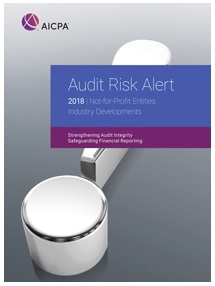
The AICPA has released the 2018 edition of Not-for-Profit Entities Industry Developments.
If you are a CPA serving the not-for-profit community, you need to read this document each year. It provides a survey of the accounting and auditing issues affecting the nonprofit world.
If you are an auditor, there are several other risk alerts you ought to be reading every year.
If you are working for a nonprofit, these alerts would give you a good survey of accounting issues in general and the audit issues your CPA will be dealing with this year.
Valuation of Gifts in Kind
Of particular interest are new comments responsive to the challenge from the California AG over valuation of GIK. The 2017 and 2016 editions had minimal comments on GIK.
The 2018 edition has a new section, Gifts-in-Kind: Reporting Contributions of Nonfinancial Assets, in paragraphs .53 through .57, which describes the AICPA’s interpretation of GAAP.
Years after the mebendazole issue has faded away, the second bullet point of paragraph .56 says that when GIK is sourced outside the U.S. and is not approved for distribution in the U.S., the meds should be valued at international prices. (If you have been following this issue for years, you realize the concession made by that comment.)
Another new section, Challenges in Auditing GIK, in paragraphs .172 through .181, goes into more detail on the accounting treatment of GIK.
The second bullet point in paragraph .176 discussing principal market points to FinREC’s opinion that geographic restrictions on the use of GIK constitute an entity restriction and not an asset restriction.
I’ve not mentioned this specific point before, but keep in mind the statement that geographic restriction is an entity restriction is the opinion of FinREC. (Check out the Audit Guide if you don’t believe me.) That’s an opinion from a source that is a heavy hitter in the CPA world, but an opinion never-the-less. That conclusion is not in the authoritative codification of accounting rules.
Sure seems to me that the discussion on GIK is responsive to the California AG’s cease and desist orders. I won’t get to see what happen inside the appeal hearings, but I’ll make a very easy guess that these paragraphs from the risk alert will be cited at length as a rebuttal to the AG.
How ‘bout a bit of inside baseball trivia? We’re talking number-of-stitches-per-inch-on-the-baseball level of minutia.
Take a look at the list of Contributors and Reviewers. I don’t recognize a lot of the names on the list, but do see a few relationships to the big R&D charities who have lots of medical GIK. Makes it a bit more apparent the new comments are a rebuttal to the three cease-and-desist orders.
Update: If you have been following this issue for a long time, the risk alert has another tidbit of trivia for your amusement. The fourth bullet point of paragraph .56 suggests that for pricing drugs that can only be sold on the international market, charities might consider looking at the International Medical Products Price Guides. This document used to be called the International Drug Pricing Indicator Guide. Back when mebendazole and albendazole were the big item, I was told repeatedly the IDPIG was not reliable, not an indicator of actual prices, and ought not be used for any pricing indications. The IMPPG website claims it is an indicator of actual transaction prices. Now that the issue of 500 mg mebendazole tablets is so far in the distant past that we can’t even see it in the rear view mirror, the audit risk alert suggests that very document as the pricing tool for international sales. Oh, yeah, 500 mg mebendazole in 500 or 1,000 tablet bottles can be bought for a price of 2.9 cents up to 3.36 cents a pill (with supplier Mission an outlier at 22.9 cents each in a 100 tablet bottle). The endorsement of that tool by the risk alert authors almost makes me wonder if the AG is arguing for a pricing indicator that is even lower than IMPPG.
Economic data
The risk alerts are a valuable tool to make sure you keep current on accounting and auditing issues. As mentioned before, I read several of them every year. If these aren’t on your annual reading list, they should be.
One minor frustration of reading the AICPA’s risk alerts is the economic stats are usually stale. I realize this is due to the long production time on such documents. (As a tech reviewer for CCH, I see from the inside how much time it takes to produce a technical document.)
In the ’18 edition, the latest GDP data is from the fourth quarter of 2017, specifically the second estimate which was released in February 2018. It is now June and I’ll guess lots of auditors will be reading this alert this month and next.
Latest unemployment data is from December 2017 and info on giving trends is for 2016.
That is old info when working on audits of 6/30 or 9/30 financial statements.
To have better trend info, I pull GDP, inflation, and unemployment data from the pertinent federal source, put it into a spreadsheet, and do my own graphing. If you want more current data on those indicators, you might consider gathering the information on your own.
I haven’t yet found a good source for more current info on giving trends. That data seems to run way behind.